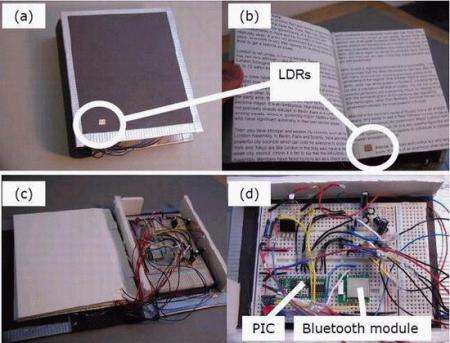April 25, 2007 feature
Browse digital media by flipping through a book

As the amount of information on the Internet, TV and radio continues to increase, one of the challenges users face is how to quickly find what they're looking for. As Jun-ichiro Watanabe of Hitachi Ltd. researched this question, he thought what could be a simpler, large-capacity, and more intuitive browser than an old-fashioned book?
“I first started thinking about ‘future radio,’ and the possibility of mapping every radio station to the pages of a book,” Watanabe told PhysOrg.com. "Listening to radio like reading a book was the initial idea or concept.”
With Watanabe’s book, users can search and access content such as TV channels, digital radio stations, bookmarked Web sites, as well as photo, audio or movie files stored on a hard drive. While current search methods—such as multiple clicking or pressing buttons, graphical user interfaces, and excessive scrolling—can handle smaller amounts of data, they become more complex and time-consuming as the data increases. Books, on the other hand, are interactive, can contain large amounts of information—and don’t crash.
“The main audience for this type of device is people who aren’t into technology,” Watanabe said. “I wanted to develop a UI [user interface] which does not change people's natural, traditional behavior, like turning over the pages.”
In this design, 0.8-mm-thick light dependant resistors (LDRs), which measure brightness, are attached to each page and the front and back covers. A peripheral interface controller (PIC) hidden in the back cover senses what page the book is open to (or if it’s closed) from the LDRs, and uses Bluetooth to wirelessly send the state of the book to the target device (e.g. TV or PC).
The different states of the book have straightforward meanings: opening the book turns the device on, closing the book turns it off; turning the pages switches pre-set content (such as TV channels); and turning the book upside down mutes the device. Users can operate the book anywhere within about 15 feet from the target device.
Watanabe has already used the device for several applications, including a TV remote control. To connect the remote control to the book, Watanabe “hacked” the remote using a PIC and relays, allowing him to switch the buttons on the remote by operating the book. He did the same thing with a digital radio control, digital photo viewer, and bookmarked Web sites.
In the future, Watanabe plans to research how electronic paper might be used in the book. Electronic paper could enable even more options, while providing color images and flexible pages. For example, Watanabe hopes to prototype functions such as play, pause, rewind, etc. Also, the content is currently manually pre-set, and Watanabe plans to develop software to make this work easier.
As simple and straightforward as the book browser is, the device also extends to the deeper modern concept of bridging the gap between the paper and electronic worlds.
“I think paper gives a new interface to the digital world,” Watanabe said. “This bridging will fill the gap between people who aren't into technology and the digital world.”
Citation: Watanabe, Jun-ichiro. “A Device for Easily Browsing Various Content Using the Metaphor of Reading Poetry.” IEEE Transactions on Consumer Electronics, Vol. 53, No. 1, February 2007.
Copyright 2007 PhysOrg.com.
All rights reserved. This material may not be published, broadcast, rewritten or redistributed in whole or part without the express written permission of PhysOrg.com.





















